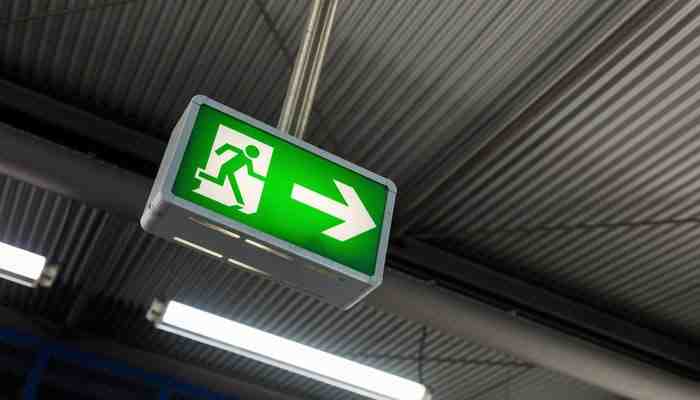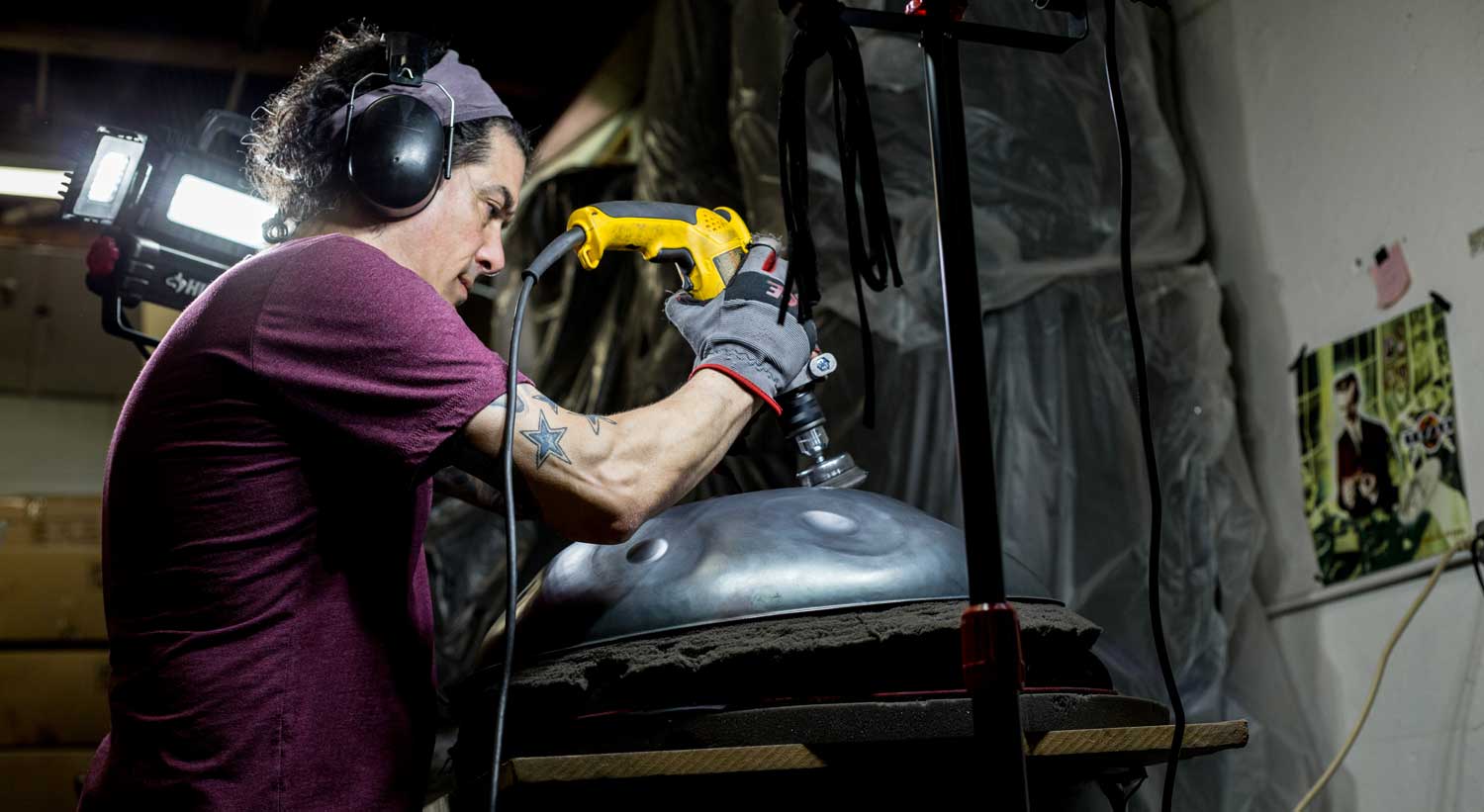The Importance of Testing Exit Signs & Emergency Light
Testing and maintenance of emergency lighting and exit signs are essential for workplace safety. Maintaining these units can be crucial for helping your personnel safely navigate to other work areas or outside in emergencies. Facility managers and supervisors should understand the role of emergency and exit lighting and the importance of testing and keeping these units in order.

Finding the Way Out
In an emergency, personnel and guests may need to find an exit or safe place within the workplace quickly. In the case of a power outage, visible exit signs and backup emergency lighting can help guide people throughout the facility.
The National Fire Protection Association (NFPA) mandates exit signs to be visible from no more than 100 feet or the listed viewing distance of the exit sign. The NFPA also requires these signs in all 'egress paths,' including ceiling height and continuous width. A lot of exit signs are lit by incandescent bulbs. As a business owner, you ought to consider an emergency and exit lighting that's internally wired into emergency backup power, which provides continuous lighting in the event of a power outage. However, internally wired backup power may not be available in many cases, so business owners should consider sources of readily available replacement batteries for any battery-backed units.
Testing and Maintaining
To properly maintain these units, business owners should consider these steps:
1. 30 Day Visual inspections - This inspection is done once every 30 days. Checking for loose or exposed wiring and securing it (frayed wiring is itself a fire hazard and loose wiring can be accidentally snagged and lead to further damage). Ensure that exit signs and emergency lights are securely mounted to the wall or ceiling. Look for any cracks or blemishes in the housing because cracked outdoor units may need to be replaced due to water seepage issues. Consider installing protective guards and shields to protect these units from physical damage.
2. Functional inspections - These units should undergo several functional tests on a monthly or yearly basis. These tests are created to check for damage to the lights' exterior and verify that the lights are functioning.
There are two types of testing mechanisms in most equipment: equipment that needs to be manually tested by pushing and holding down the 'Test Button' on the unit) and equipment designated as 'self testing' has built-in circuitry that can perform the 30 second monthly and 90 minute annual tests).
Manual testing equipment requires you to find the 'push-to-test' button that interrupts AC power and engages the backup battery. Exit signs should stay illuminated, and emergency lighting should turn on. Hold the button for 30 seconds, observing that the illumination stays on for the full 30 seconds.
Self-testing equipment is ideal for facilities with a large number of units. It has a 'push-to-test' button and a diagnostic LED that illuminates to convey test results. The button should be pressed two times to activate the 30-second test. After a while, examine the LED tell-tale. Steady green indicates normal service, while red indicates a failure of some sort. You can also set the units to perform a 30-second battery test every 30 days automatically.
3. Record Keeping - Keep written records of testing and maintenance for further review. For any unit that was not tested, document the unit's location and a reason for the lack of testing.
Conclusion
In the event of an emergency in your facility, would your personnel or guests know where the nearest emergency exit would be? Making sure your personnel and visitors feel safe in your facility is extremely important.
Keep written records of visual inspections and tests using effective solutions like The Checker.
The Benefits of Smart Emergency LED Lighting
The Benefits of Smart Emergency LED Lighting
Emergency lighting is a fundamental feature of fire safety and emergency evacuation, playing a critical, life-saving role in commercial and industrial settings. Should a power outage occur, regardless of whether it’s a result of mains failure, fire or circuit error, effective emergency lighting will direct the occupants out of the facility safely. Where the system is ineffective, people’s lives are put at risk and the outcome can be devastating.
Effective emergency lighting goes beyond showing people a way out of the building. It also helps them avoid harm from the potentially dangerous obstacles, like furniture and equipment, which can pose a risk during an evacuation. In high occupancy settings, such as hospitals and schools, people can even be a hazard to each other as they all try to leave at the same time. An effective system gives them safe transit, preventing injury and stopping them from becoming trapped en route to the exit.
Ensuring that emergency lighting remains effective is, therefore, one of the facilities manager’s most important duties, requiring them to carry out regular maintenance and testing. This task, however, can be both protracted and labor-intensive, especially in large facilities or on multi-site estates. Nor is it easy to undertake when the maintenance of other critical equipment is often given priority. This creates a problematic dilemma for property managers, who would be fully aware of the potential outcomes should the system fail.
Shining a Light on Regulations
The most recent lighting codes are very exacting. The regular testing of emergency lighting units is now compulsory in the US, and organizations must comply with both the National Fire Protection Association’s National Electrical Code (NFPA 70) and the Life Safety Code (NFPA 101). Comparable lighting regulations are enforced in other countries.
In the US, the regulations dictate not only what kind of testing must be done but also how often, monthly and yearly tests. NFPA 101 goes even further, stipulating how the emergency lighting system should be designed and what management strategies the organization needs to implement. On top of this, facilities managers must also keep documentation of the tests. Should a problem occur during testing, the Occupational Safety and Health Administration (OSHA) or any other Authorities Having Jurisdiction (AHJ) may demand to see additional records as evidence that the organization has carried out the necessary remedial action and retesting.
To fulfill these demanding obligations, facility managers will need to manage the effectiveness of emergency lighting even more rigorously, especially across multi-site estates. Non-compliance can lead to large fines, as much as six-figure sums for repeated or deliberate violations. However, despite these regulatory deterrents, the challenges of undertaking manual, monthly functional tests mean they continue to be the principal failure point for organizations.
Switching On to a Smarter Solution
The quandary for site managers is how to win over these maintenance challenges, ensure occupant safety and comply with regulations. The solution for all these is to be found in the on-board intelligence, built-in diagnostics and self-testing features of the next-generation, smart, emergency LED fixtures and drivers. The technology used in the latest emergency luminaires is so advanced that they can test themselves. Should a battery, charger, or light source problem occur, its built-in LED indicator light emits a pattern of flashes that tells the facilities manager exactly which fault needs rectifying. When put into test or emergency mode, they can also identify issues with batteries, drivers, and LED arrays, as well as with charging or discharging.
The result is that the entire testing process becomes fully automated, end-to-end. The arduous routine of testing each individual emergency fixture manually is permanently eliminated. The process of having to press a unit’s test button for 30 seconds in order to simulate an outage and then log the results is superseded by the far simpler and quicker task of visually checking the indicator lights. Doing this and recording each unit’s status once every 30 days is sufficient testing to secure the system against potential faults. Furthermore, it even eradicates the need to carry out the more time-consuming, 90-minute functional testing.
The benefit for facilities managers is that emergency lighting systems that feature self-testing and self-diagnostics substantially reduce their workload. Compared to manual testing, the time needed to inspect and maintain the system can be reduced to approximately a third of what it was. This frees up employees, cuts maintenance costs and reduces the prospect of being penalized for non-compliance.
A Brighter Future
Where the management of emergency lighting systems involves manual testing and compulsory record keeping, organizations face a raft of challenges, especially if they operate large or multi-site facilities. Unsurprisingly, managers responsible for occupant safety are finding that smart, emergency LED lighting technology, with self-testing and self-diagnostic functionality, helps overcome those challenges while making establishments safer for their occupants.
Daniel Brenzel is Product Manager for Emergency Lighting Systems at Fulham Co., Inc. Visit to learn more.
An Electrician’s Role In Emergency Lighting — Zimmerman Electric Company
As important as emergency lighting is, once it’s installed, most people don’t give it a second thought. There is a trust and assumption that they’ll come on when necessary. And while they don’t need to be a constant concern, it is important that they are properly serviced and maintained. The best way to maintain the lights is to have a local and certified electrician involved from the installation point. Licensed electricians are qualified to help maintain a safe and up-to-code emergency lighting system.

Installation
Some emergency lights even come with an Energy Star rating!
Despite the growing trend and prevalence of DIY options, it’s still the best to contract a licensed electrician. When it comes time to do the installation of a new emergency lighting system it is far better to be safe than have a failure in a potential catastrophe. Even if it’s just one new box, the electrician will be able to do it safely, and efficiently.
Some emergency lights are wired into the buildings main circuits, and then others are set up on automatic batteries that will turn on when the power is out in the building.
Licensed electricians will know how to set it up, and be well versed in the requirements for OSHA regulations, and how to set it up to best meet the requirements by law, and make sure that the building is as safe as it possibly can be.
Testing
OSHA is very severe about Emergency lighting systems. Having inadequate light systems on an inspection comes with a $7,000 fee for the first offense, and has fines upwards of $70,000 for every consecutive inspection failure. That’s partly why it’s important to have the lights tested and inspected outside of OSHA regulations regularly. Have a licensed electrician come in once a month and test the battery, bulbs, and general functionality and save the headaches with OSHA.
Make sure each of these inspections and tests are documented, as well as the results. This will help reduce the risk of liability in the event OSHA finds a failure, or an emergency happens and something doesn’t go quite right. It doesn’t take them long to identify potential problems and either resolve them or leave careful instructions on how.


![31 Best IPTV Services for FireStick, Android TV, PC [Dec 2021]](https://www.lampsofbible.com/storage/upload/Images/_1639646173_nXrO23JGnM.jpg)





